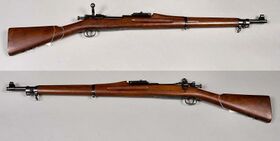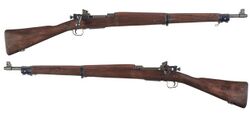M1903 GSR rifle
This article is incomplete because it is pending further input from participants, or it is a work-in-progress by one author. Please comment on this article's talk page to share your input, comments and questions. Note: To contribute to this article, you may need to seek help from the author(s) of this page. |
| M1903 Gallian Service Rifle | |
|---|---|
 M1903 GSR at the Randgriz Museum of Arms and Weapons | |
| Type | Bolt-Action Rifle |
| Service history | |
| In service | 1903-Present (in certain modern units) |
| Used by | |
| Wars | First Europan War Second Europan War War of Lorican Aggression |
| Production history | |
| Manufacturer | RRO |
| Produced | 1903-1952 |
| Specifications | |
| Weight | 3.94 kg (8.7 lb) |
| Length | 1,097 mm (43.2 in) |
| Barrel length | 610 mm (24 in) |
| Cartridge | .30-06 Theimer; |
| Action | Bolt action |
| Rate of fire | 10–15 rounds/min |
| Muzzle velocity | 854 m/s (2,800 ft/s) |
| Effective firing range | 914 meters (1,000 yd) |
| Maximum firing range | 5,029 meters (5,500 yd) with .30 M1 Ball cartridge |
| Feed system | 5-round stripper clip, 25-round (Air Service variant) internal box magazine |
| Sights | Flip-up rear sight graduated to 2,500 meters (2,700 yd), barleycorn-type front sight M1903A3: Aperture rear sight, barleycorn-type front sight |
The M1903 Gallian Service Rifle or GSR is a bolt-action, five-round rifle developed in Gallia-Bruhl. Its alternative designation was the M1903 Theimer.
It was formally adopted in 1903 as the standard issue rifle for the Royal Gallian Armed Forces. However, the fast-firing 10-round Galliagewehr 35 was developed to replace it but there were barely enough to supply troops during the First Europan War so the GSR remained in service longer. It was gradually withdrawn as the official main battle rifle by 1930 due to the Galliagewehr 35 being readily available. As an alternative, it was replaced by the Lucian Lena-Elfield but it remained in service up to the Second Europan War and the early stages of the War of Lorican Aggression as a sniper rifle alongside the Enfield. However, certain divisions and regiments retained its use when certain terrain favoured the GSR. The lethality of the .30-06 Theimer was another decisive factor for its retaining in service and use with various special forces.
Development
During the 1898 Concordian-Archadian War, the experiences of Concordian forces against the Carcano modello 1895 and the Estharian Meuser M1895 during the Battle of San Lorenzo Hill, where 750 Archadian troops greatly delayed the advance of 15,000 Concordian troops armed with the Krag-Mauserheim M98 and single-shot trapdoor rifles. Archadian troops inflicted massive casualties on the Concordians with 1,750 versus 210 on the Archadians. As a result of these problems, many Concordian generals who fought in the conflict recommended the replacement of the Krag.
Captured models of the Estharian Meuser and the Archadian Carcano were taken immediately to be examined. The Concordian Army contracted several foreign engineers, including Wolfgang Theimer. The Concordian Army requested a very demanding proposition for Theimer, in which if his rifle could surpass the the quality of the two rifles, he was to be paid an annual royalty of 250,000 Concordian Gils (15,000,000 Concordian Gils in present time). Theimer accepted nonetheless. The army submitted captured models of the Meuser and the Carcano, but Theimer had no need of it, being that he had a close bond with Emil Meuser, who was the inventor and designer of the M1895. Theimer approached him and asked if he could borrow several technologies and designs found on the M1895. Emil agreed on the condition that he was paid 1/5ths of Theimer's royalty per rifle produced. Theimer agreed.
In 1900, Theimer began work on the rifle. In the spring of that year, Theimer argued that he could make the bolt handle higher pressures, such that even stronger rifle calibre cartridges can be fired. Theimer adopted the cock-on-opening bolt, 30" barrel, magazine cutoff, stock, and sights of the Krag-Mauserheim with the dual locking lugs, external claw extractor, and staggered-column magazine of the Meuser M1895. A large safety lug was added to the side of the bolt behind the extractor, which would engage the receiver bridge and prevent the bolt moving rearwards. The bolt handle was bent downwards, to make operation of the bolt faster.
However, the Gallian Army became interested in the development of the new rifle, hence a meeting was arranged between Gallian and Concordian military officials. In test, it was found that the rifle was too long, and that it offered a poor maneuverability in close quarters situations. Longer barrels also offered no appreciable ballistic advantage. Hence Theimer shorted the barrel to 24". The rod bayonet was also found to be unfavourable for both Gallian and Concordian officers, particularly Concordian Prime Minister Theodore Rondstadt, who was a veteran during the Concordian-Archadian War. As a result, a blade-type bayonet was created and designated as the M1905.
A new cartridge was also developed by Theimer. Instead of using the existing 220-grain round tip bullet that offered a muzzle velocity of 2,300 ft/s , a new 150-grain pointed bullet that offered a muzzle velocity of 2,800 ft/s was adopted into the rifle and the performance was deemed highly satisfactory. The new Gallian catridge was designated as "Cartridge, Ball Caliber .30, Model of 1906". The new cartridge would also be famously known as the ".30-06 Theimer", used in many rifles and machine guns, and is still a popular civilian cartridge to this day.
M1903A3
Combat Service
Users
![]() Alteria: Lend-lease; issued to second-line units
Alteria: Lend-lease; issued to second-line units
![]() Altissia: Used by the Royal Altissian Militia
Altissia: Used by the Royal Altissian Militia
![]() Basel-Ebel: Rarely issued
Basel-Ebel: Rarely issued
![]() Concordia and the Soryu: Standard issue during EWI
Concordia and the Soryu: Standard issue during EWI
![]() Dalmasca and Nabradia: Standard issue during EWI and EWII
Dalmasca and Nabradia: Standard issue during EWI and EWII
![]() Erebonian Empire: Issued in special units and as a sniper rifle; Still in use by the Honor Guards and in Ceremonial Events
Erebonian Empire: Issued in special units and as a sniper rifle; Still in use by the Honor Guards and in Ceremonial Events
![]() Gallia-Bruhl: Standard issue rifle from 1903-1921, replaced by the Galliagewehr 35 and occasionally issued, sniper rifle variants remained in service until 1965; Still in use by the Honor Guards and in Ceremonial Events
Gallia-Bruhl: Standard issue rifle from 1903-1921, replaced by the Galliagewehr 35 and occasionally issued, sniper rifle variants remained in service until 1965; Still in use by the Honor Guards and in Ceremonial Events
![]() Jutland-Gimli: Received GSRs from Alteria. Used by special units.
Jutland-Gimli: Received GSRs from Alteria. Used by special units.
![]() New Akiba: Lend-lease; Still in use by the Honor Guards and in Ceremonial Events
New Akiba: Lend-lease; Still in use by the Honor Guards and in Ceremonial Events
![]() Nibelheim-Saxe-Hanover: Lend-lease
Nibelheim-Saxe-Hanover: Lend-lease
![]() Nihhon-koku: Lend-lease; Still in use by certain military academies, Honor Guards, and in Ceremonial Events.
Nihhon-koku: Lend-lease; Still in use by certain military academies, Honor Guards, and in Ceremonial Events.
![]() Rubrum: Lend-lease, Still in use by the Rubrumian Arctic Regiment and the Royal Rubrumian Arctic Police
Rubrum: Lend-lease, Still in use by the Rubrumian Arctic Regiment and the Royal Rubrumian Arctic Police
![]() United Kingdom: Issued to special units, including the Lucis Commandos
United Kingdom: Issued to special units, including the Lucis Commandos
